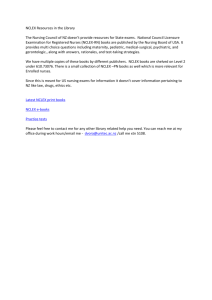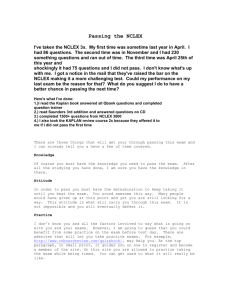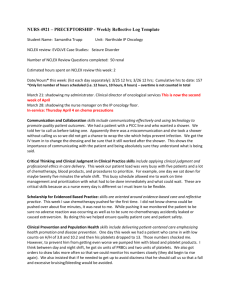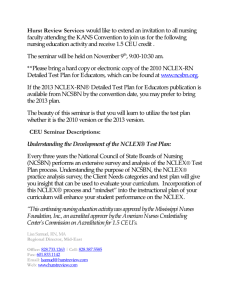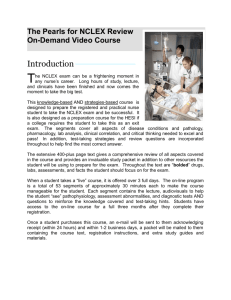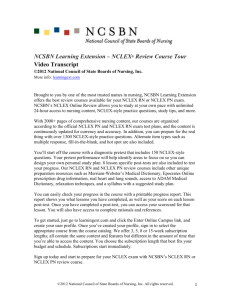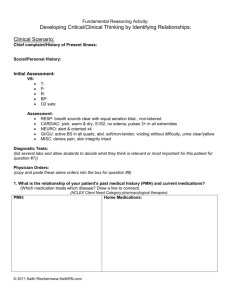Criteria-4.3-2013.doc
advertisement
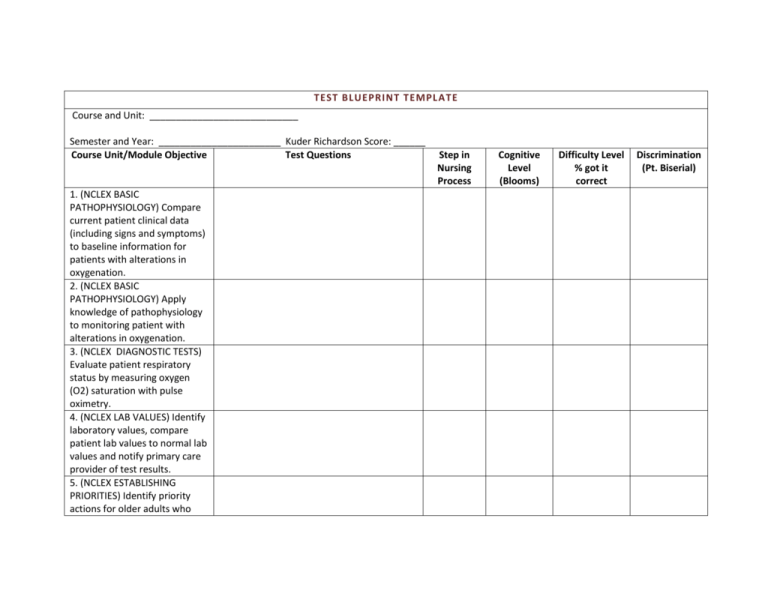
TEST BLUEPRINT TEMPL ATE Course and Unit: ____________________________ Semester and Year: _______________________ Kuder Richardson Score: ______ Course Unit/Module Objective Test Questions 1. (NCLEX BASIC PATHOPHYSIOLOGY) Compare current patient clinical data (including signs and symptoms) to baseline information for patients with alterations in oxygenation. 2. (NCLEX BASIC PATHOPHYSIOLOGY) Apply knowledge of pathophysiology to monitoring patient with alterations in oxygenation. 3. (NCLEX DIAGNOSTIC TESTS) Evaluate patient respiratory status by measuring oxygen (O2) saturation with pulse oximetry. 4. (NCLEX LAB VALUES) Identify laboratory values, compare patient lab values to normal lab values and notify primary care provider of test results. 5. (NCLEX ESTABLISHING PRIORITIES) Identify priority actions for older adults who Step in Nursing Process Cognitive Level (Blooms) Difficulty Level % got it correct Discrimination (Pt. Biserial) have an alteration in oxygenation. 6. (NCLEX UNEXPECTED RESPONSE & POTENTIAL/COMPLICATIONS) Recognize complications, intervene, document and report findings for unexpected negative response to therapy, tests, treatments or procedures in patients with alterations in oxygenation. 7. (NCLEX NUTRITION) Reinforce nutritional teaching being mindful of cultural considerations for patient with dyspnea. 8. NLCEX SAFE USE OF EQUIPMENT: Demonstrate safe use of oxygen equipment for patient care. 9. (NCLEX DOSAGE CALCULATIONS) Use nursing judgment when performing calculations needed for medication administration. 10. (NCLEX PHARMACOLOGY THERAPIES) Use resources to check on purposes and actions of pharmacological agents, identify pt's expected response to medication, and reinforce education regarding medication effects for alterations in oxygenation. 11. (NCLEX PHARMACOLOGY EXPECTED ACTIONS) Evaluate pertinent data (e.g., vital signs, lab results, allergies) prior to medication administration (including PRN medications) and evaluate patient response to medications related to oxygenation. 12. (NCLEX HEALTH PROMOTION & CULTURAL AWARENESS) List risk factors and reinforce teaching considering cultural influences related to healthy lifestyle choices for older adult patients with alterations in oxygenation. 13. (NCLEX HEALTH PROMOTION) Identify the need for immunizations for patients with alterations in oxygenation (influenza, pertussis, pneumococcal, etc.), identify precautions, contraindications and potential complications from immunizations. Test Validity: The test blueprint determines that the information taught is measured in the test. Test Reliability: Measures the consistency of test scores. Test statistics provide information on test reliability. Kuder Richardson: Measures the reliability of the entire test Kuder Richardson for classroom tests should be between .50 and .80 (Wittman & Godshall, 2009). Item difficulty (P value)= .5 or 50% of students get question correct (should be between 30 and 90% or .3 to .9 ) Point Biserial (Item Discrimination): .2 is ok but should be strengthened, .3 are good, .4 are very good. (Wittman & Godshall, 2009). Kehoe, J. (1995). Basic item analysis for multiple-choice tests. Practical Assessment, Research & Evaluation, 4(10). Wittmann-Price, R., & Godshall, M. (2009). Certified Nurse Educator Review Manual. New York: Springer Publishing Co. Developed by Sue Field DNP, RN updated 6/30/2012
